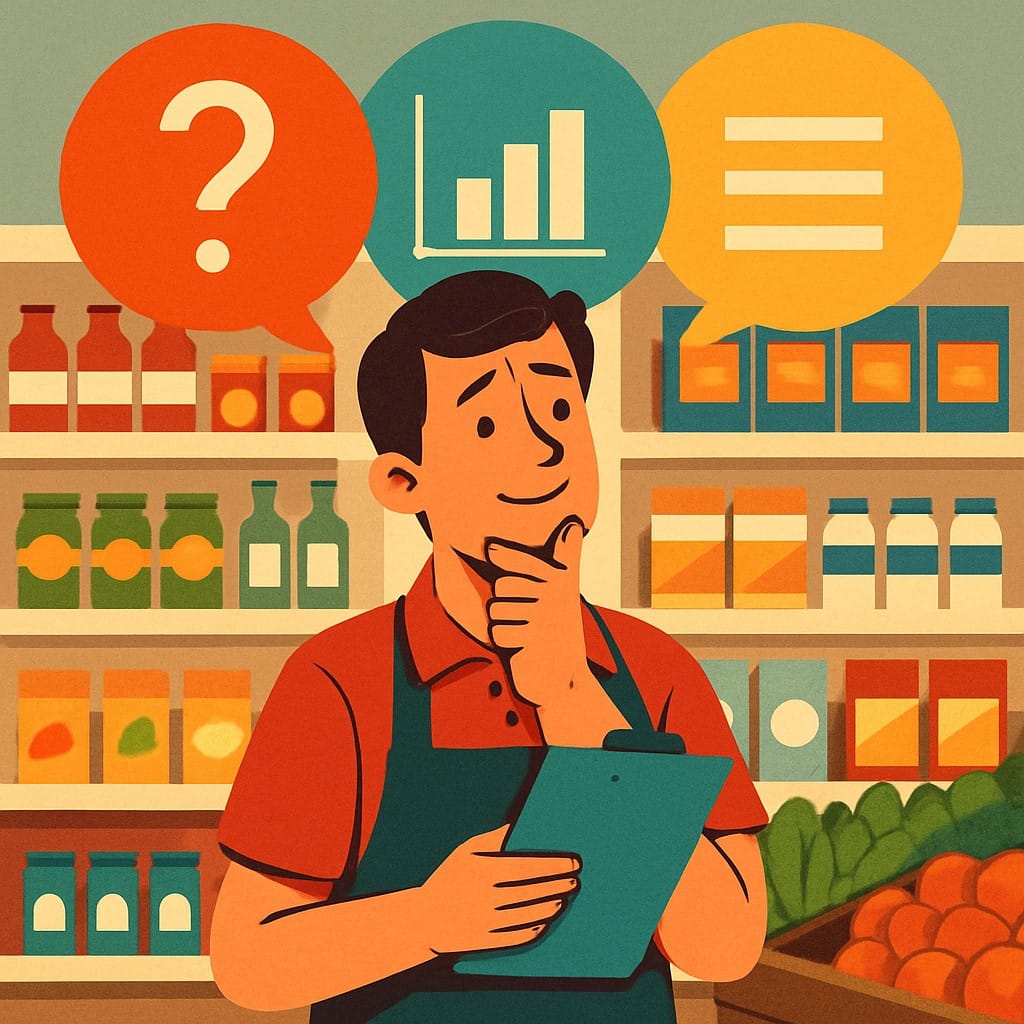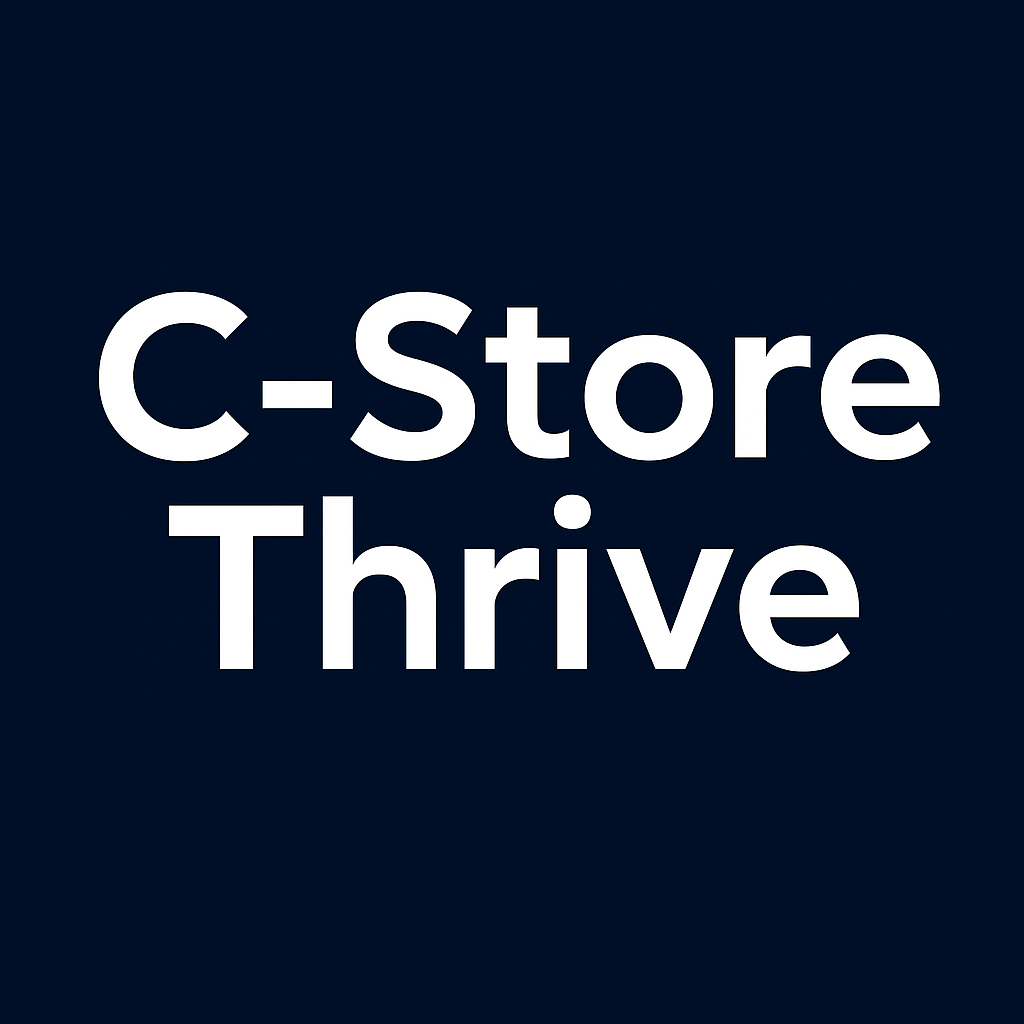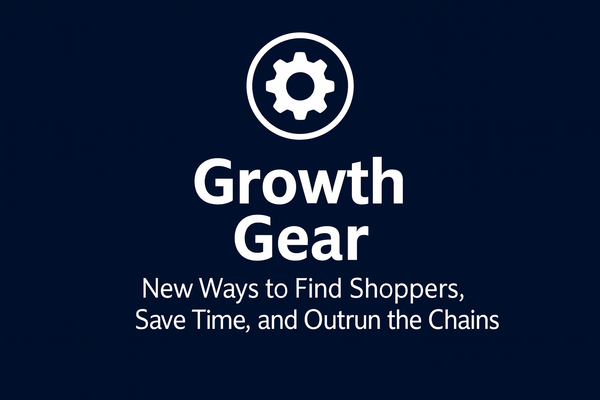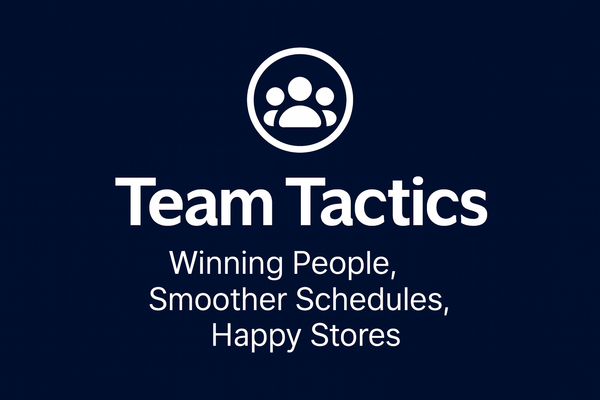Making Sense of the Mess: How Smart Category Definitions Transform Your Store
When Ezra Thompson started working at Survival Stop, the store's organization made absolutely no sense to him. Gum sat next to motor oil, energy bars were scattered across three different sections, and customers constantly asked where to find items.

When Ezra Thompson started working at Survival Stop, the store's organization made absolutely no sense to him. Gum sat next to motor oil, energy bars were scattered across three different sections, and customers constantly asked where to find basic items. His manager, Fatima Al-Zahra, just shrugged and said, "That's how we've always done it."
But after attending a company training session on category management, Ezra realized the store wasn't just disorganized—it was losing money. Customers who couldn't find what they wanted quickly often left empty-handed. Worse yet, related items that should've been sold together were separated by entire aisles, killing cross-selling opportunities.
"It was like trying to find ingredients for a recipe when the spices were in the garage, vegetables in the basement, and meat in the attic," Ezra explains. "Once we learned how to define and organize proper categories, everything clicked. Sales went up, customers complained less, and honestly, our jobs became way easier."
What Categories Actually Mean
Category management isn't just fancy retail jargon—it's about grouping products in ways that make sense to customers and drive sales. Think of categories as neighborhoods where related items live together, making shopping faster and encouraging customers to buy multiple items.
Customer logic trumps warehouse logic every time. Just because two products come from the same supplier doesn't mean they belong together on shelves. Energy drinks might ship with motor oil, but customers looking for afternoon pick-me-ups aren't thinking about car maintenance.
Shopping missions define categories better than product specifications. When someone needs a quick breakfast, they want energy bars, coffee, and pastries in one spot—not scattered based on whether items are "baked goods" or "nutrition products."
Impulse opportunities multiply when categories make intuitive sense. Customers buying chips are likely candidates for dip, but only if both items are nearby and easy to spot together.
Rajesh Gupta learned this during his store's reorganization: "We used to put all 'health products' together—vitamins, protein bars, pain relievers, everything. Customers hated it. Now, protein bars are with snacks, pain relievers are near the pharmacy section, and vitamins have their own health corner. Makes way more sense."
The Big Picture: Major Category Groups
Successful convenience stores typically organize around six to eight major category groups that match customer shopping patterns rather than supplier convenience.
Food & Beverages dominates most c-store sales but needs smart subdivision. Hot foods, cold drinks, snacks, and grocery basics each serve different customer needs and deserve distinct treatment.
Automotive products serve car-related missions, from emergency fixes to routine maintenance. Grouping oil, windshield washer fluid, and air fresheners together serves customers dealing with car issues.
Health & Personal Care addresses immediate needs like headaches, hygiene emergencies, and basic wellness. These purchases are often urgent, so easy location is crucial.
Tobacco & Alternative Products require special handling due to regulations but benefit from logical organization within legal constraints.
General Merchandise covers everything else—phone chargers, lottery, newspapers, seasonal items. The catch-all nature requires extra attention to prevent chaos.
"Before category training, our 'general merchandise' section was basically a junk drawer with price tags," admits Chen Wei-Ming, whose store restructuring improved customer satisfaction scores by 23%. "Now even our miscellaneous items have logical groupings that help customers find stuff."
Food Categories: Beyond "Stuff You Eat"
Food represents the biggest opportunity for smart category definition because eating occasions vary dramatically throughout the day and week.
Breakfast solutions serve morning shoppers who need quick meal options. Coffee, pastries, energy bars, and grab-and-go sandwiches form a natural grouping based on timing rather than food type.
Lunch combinations target midday hunger, with sandwiches, salads, chips, and drinks positioned for easy meal assembly. Customers appreciate one-stop lunch shopping during limited break time.
Snack destinations satisfy between-meal cravings with candy, chips, nuts, and treats organized for browsing and impulse purchases. This category encourages exploration and multiple selections.
Dinner helpers assist time-pressed shoppers with basics like bread, milk, eggs, and prepared foods for quick meal solutions.
Keiko Tanaka's experience illustrates effective food categorization: "We created a 'lunch rush' section near the front with sandwiches, chips, drinks, and fruit—everything for a complete meal. Sales during 11 AM to 2 PM jumped 34% because customers could grab lunch without hunting through the whole store."
Beverage Strategy: Liquid Logic
Beverages deserve special attention because they're high-frequency purchases with clear consumption patterns that smart categorization can leverage.
Energy & Performance serves customers needing alertness or workout fuel. Energy drinks, sports beverages, and protein shakes share similar usage occasions despite different formulations.
Refreshment & Hydration addresses basic thirst with water, sodas, and juices organized for easy selection based on flavor preferences and size needs.
Hot Beverages creates a destination for coffee, tea, and hot chocolate, especially important during colder months or morning rushes.
Specialty & Premium showcases higher-margin drinks like craft sodas, kombucha, and organic options that appeal to specific customer segments.
"Beverage reorganization was our biggest win," reports Dmitri Volkov, whose cooler restructuring increased beverage sales 19%. "We moved energy drinks near the register for impulse purchases, grouped all waters together, and created a 'premium' section. Customers find what they want faster, and we sell more high-margin items."
Snack Attack: The Impulse Goldmine
Snack categories present the biggest impulse opportunity in convenience stores, but success requires understanding why people choose specific snacks at specific times.
Sweet treats satisfy dessert cravings and emotional eating, with candy, cookies, and pastries positioned for maximum impulse appeal.
Salty satisfaction addresses savory cravings with chips, nuts, jerky, and crackers organized to encourage variety purchases.
Healthy alternatives serve guilt-conscious customers with granola bars, dried fruit, and protein snacks grouped separately from indulgent options.
Sharing sizes target customers buying for groups with family packs and multi-serves positioned for easy identification.
Abiola Okonkwo's snack restructuring demonstrates category power: "We separated 'guilty pleasure' snacks from 'health-conscious' options instead of mixing everything together. Both sections perform better now because customers can find their preferred snack style without feeling judged."
Beyond Food: The Support Categories
Non-food categories often get neglected, but they serve crucial customer needs and generate solid margins when organized thoughtfully.
Automotive essentials group car-related products by usage situation. Emergency items like coolant and oil stay together, while comfort items like air fresheners and phone mounts form another cluster.
Personal care basics address hygiene emergencies and daily needs. Travel-size items, pain relievers, and feminine products deserve prominent, accessible positioning.
Technology helpers serve our device-dependent customers with chargers, earbuds, and phone accessories grouped by device type rather than product category.
Seasonal solutions rotate based on weather and holidays but maintain logical internal organization. Summer items like sunscreen and bug spray belong together regardless of supplier.
"Our automotive section used to be a disaster," recalls Esperanza Morales. "Oil filters next to candy, windshield fluid behind cigarettes—completely random. Now all car stuff lives together, and we actually sell automotive products instead of just stocking them."
The Cross-Merchandising Connection
Smart category definition creates natural cross-merchandising opportunities where complementary products from different categories drive additional sales.
Meal occasion bundling places drinks near food items and snacks near beverages to encourage complete purchase solutions rather than single items.
Problem-solving partnerships group products that address the same customer needs. Hangover relief might include pain relievers, sports drinks, and energy bars from different traditional categories.
Seasonal combinations temporarily link categories during holidays or weather events. Summer car care might include automotive products, cooling towels, and cold beverages.
Yuki Nakamura's cross-merchandising success shows the potential: "During flu season, we created a 'feel better' display with medicine, tissues, soup, tea, and comfort food from five different categories. It became our highest-grossing endcap ever."
Practical Implementation: Making It Work
Category definition sounds theoretical, but implementation requires practical steps that employees can execute without disrupting daily operations.
Start with customer observation to understand actual shopping patterns. Watch how people move through the store and what they look for together.
Test small sections before major reorganization. Prove category concepts work in limited areas before store-wide changes.
Maintain flexibility because customer needs evolve seasonally and locally. Categories should guide decisions, not become rigid rules that ignore reality.
Measure results through sales data and customer feedback. Successful categories increase sales per square foot and reduce customer complaints about product location.
The Employee Impact
Well-defined categories make employees' jobs easier while improving customer service and sales performance.
Faster restocking happens when products have logical homes. Employees spend less time wondering where items belong and more time serving customers.
Better customer assistance becomes possible when staff understand category logic. Helping customers find related items becomes natural rather than challenging.
Improved sales opportunities arise when employees can suggest complementary products from nearby categories rather than sending customers across the store.
"Category organization cut my restocking time in half," notes Fatou Diallo, whose efficiency improvements earned recognition from management. "When everything has a logical place, the job becomes way less stressful and more productive."
The Bottom Line on Categories
Effective category management transforms convenience stores from random product collections into customer-focused shopping destinations. Employees working in well-organized stores report higher job satisfaction, better customer interactions, and clearer understanding of their role in store success.
"Categories aren't just about where stuff goes," reflects Hassan Prinski, whose store consistently outperforms district averages. "They're about understanding customers and making their lives easier. When we get that right, everyone wins—customers, employees, and the business."
For convenience store employees, mastering category fundamentals provides valuable skills that transfer across retail settings while making current jobs more manageable and rewarding. Understanding why products go where they do transforms routine tasks into strategic contributions to store success.





